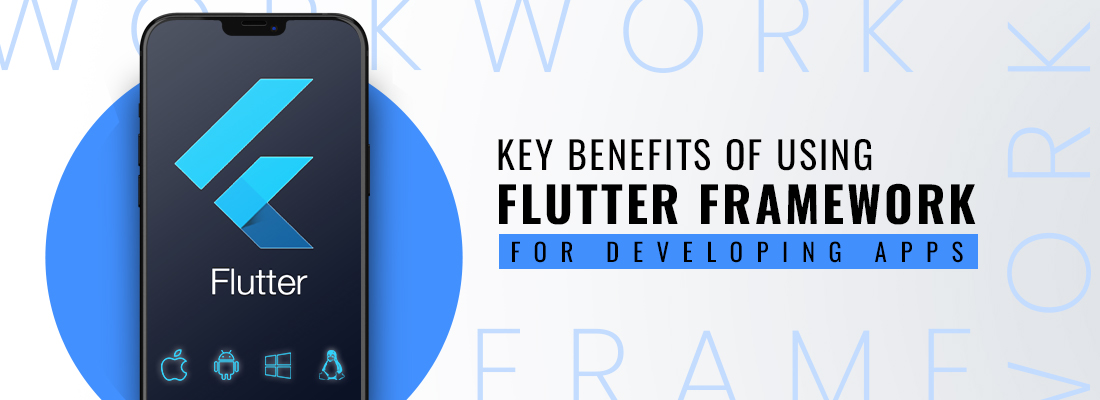Key benefits of using Flutter Framework for developing apps 2024

Google developed the mobile app development platform called Flutter. It enables the development of cross-platform, web, desktop, and mobile apps for iOS and Android devices. Dart, a reactive programming language, is used by Flutter to accelerate and simplify development compared to traditional approaches. The Flutter framework's powerful graphics and animation packages make it simple to design user interfaces that react smoothly to the touch. Read on to discover everything you need to know about Flutter if you're curious to learn more or are considering utilizing it to create your next project.
How does Flutter work?
Flutter is an app SDK that allows users to create high-quality native apps on Android and iOS. With Google's new Fuchsia operating system, it is also the main method for creating cross-platform apps. You can easily create user interfaces that are attractive, quick, and responsive with the Flutter framework. Additionally, the framework is expandable, making it simple to include new features and functions. When constructing a Flutter app, you'll be focusing on what's called a "widget."
Widgets are the basic building blocks of a Flutter app, and they're used to generate both the visual components of an app (like buttons and text) and the functional parts (like Stateless Widgets).
Stateless widgets and Stateful widgets are the two different categories of widgets.
Stateless Widgets lack any internal state, as their name suggests.
These widgets are the simplest and are frequently used for buttons or text.
Stateful Widgets are those that can change their state after creation.
Examples: Checkbox, InkWell, Slider, TextField, and Radio Button are examples of Stateful widgets.
When constructing a Flutter app, you'll be focusing on what's called a "widget."
Widgets are the basic building blocks of a Flutter app, and they're used to generate both the visual components of an app (like buttons and text) and the functional parts (like Stateless Widgets).
Stateless widgets and Stateful widgets are the two different categories of widgets.
Stateless Widgets lack any internal state, as their name suggests.
These widgets are the simplest and are frequently used for buttons or text.
Stateful Widgets are those that can change their state after creation.
Examples: Checkbox, InkWell, Slider, TextField, and Radio Button are examples of Stateful widgets.
What Is the Flutter Framework?
Both their widget-based UI library and their software development kit (SDK) make up the Flutter framework. This library includes a variety of reusable user interface components, including slides, buttons, and text inputs. The Dart programming language will be used by developers to create mobile applications utilizing the Flutter framework. Dart is a typed object programming language with a syntax similar to JavaScript that focuses on front-end development.Key features of Flutter Framework
Flutter Development Provides Access to Native Features
Access to native functionalities is another noteworthy benefit of Flutter. Native languages must be used to build features like geolocation and the camera, although Flutter developers can access native functionalities by utilizing Objective-C, Swift, or Java. Flutter apps operate identically to native ones in terms of speed. Flutter does not require intermediate files, which makes it different from most cross-platform. As a result of development tool framework representations, the applications are built directly into the machine code.Accessibility and internationalization
Internationalization, which is creating different language and regional versions of your app, typically occurs after the software itself is developed and might result in numerous inconsistencies. Flutter offers tools that streamline this procedure and integrate it into development. Flutter also supports accessibility, allowing large fonts, enhanced contrast, screen readers, etc.Open source and an active community
Flutter is an open-source platform that is free to use and has a thriving community that contributes to its excellent documentation and helps developers with any problems they might run across. For people who wish to start studying Flutter or advance their abilities to build a platform using Flutter, there are also plenty of tutorials available.Reducing testing costs
The tools and functionalities offered by Flutter make it simple and accurate to design an interactive mobile app. As a result, testing and improvement expenses will decrease. Additionally, the Flutter SDK provides several testing tools to assist with the code base testing for numerous apps on a single platform. The test cycles can be smaller and shorter using built-in testing tools. Additionally, because you do not need different testing platforms or tools, testing costs are reduced. The Flutter App SDK not only streamlines and simplifies testing in general, but it also minimizes errors in the codebase, allowing the app to be deployed as soon as possible.Types of businesses that should use Flutter
 Following are a few instances of companies that could profit from utilizing Flutter:
Following are a few instances of companies that could profit from utilizing Flutter:
